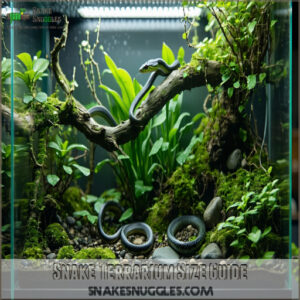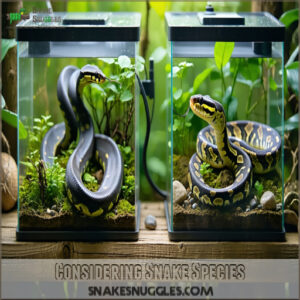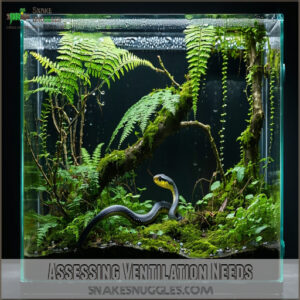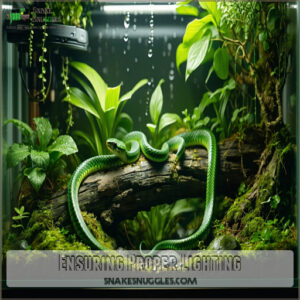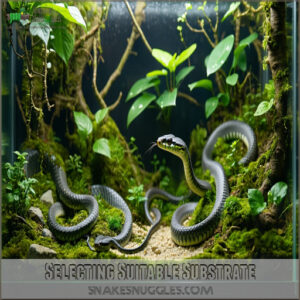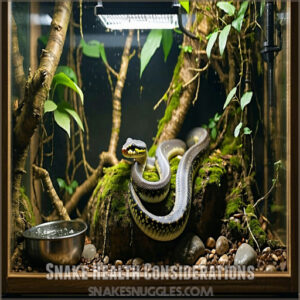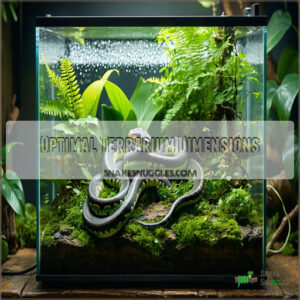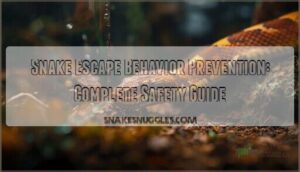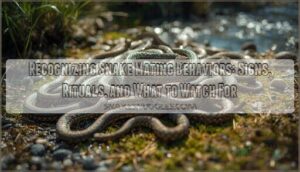This site is supported by our readers. We may earn a commission, at no cost to you, if you purchase through links.
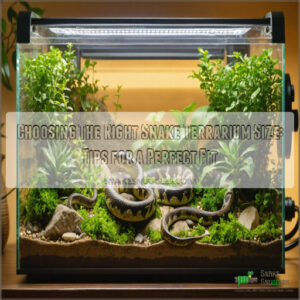
Start by measuring your snake from head to tail.
A good rule is a tank that’s at least 1.5 times its length.
For smaller snakes, 20-30 gallons works, but larger species may need 60 gallons or more.
Climbing species? Opt for extra height.
Ventilation is key, so make sure airflow without risking escapes.
Pick durable materials like glass or plastic for easy cleaning and safety.
Always leave space for hiding spots, enrichment, and movement.
Remember, a spacious terrarium keeps your snake stress-free and healthy—no one likes feeling cramped!
Table Of Contents
- Key Takeaways
- Snake Terrarium Size Guide
- Choosing Right Terrarium
- Terrarium Design Features
- Selecting Suitable Substrate
- Snake Health Considerations
- Optimal Terrarium Dimensions
- Frequently Asked Questions (FAQs)
- How big should a snake terrarium be?
- How do I choose a snake terrarium?
- How big should a corn snake terrarium be?
- How do you keep a snake in a terrarium?
- How big should a snake tank be?
- How do you choose a snake tank?
- How big should my snake terrarium be?
- Is a 75 gallon tank too big for a ball python?
- What is the rule of thumb for snakes?
- How big of an enclosure does a 6ft snake need?
- Conclusion
Key Takeaways
- Measure your snake’s length and get a tank at least 1.5 times longer to ensure enough space for movement and comfort.
- Plan for growth by choosing a tank that will fit your snake’s adult size, especially for fast-growing species.
- Pick terrarium materials like glass or plastic that are durable, easy to clean, and ensure proper ventilation for airflow.
- Add hiding spots, enrichment features, and create a temperature gradient to keep your snake healthy and stress-free.
Snake Terrarium Size Guide
Choosing the right terrarium size makes sure your snake has enough space to move, hide, and grow comfortably.
By measuring your snake and planning for future growth, you can select dimensions that meet its specific needs.
Measuring Snake Length
Measuring snake length accurately is the first step in determining the ideal terrarium size.
Use flexible tools like tailor’s tape for precise snake length measurement.
Aim for the snake to stretch naturally without tension.
Understanding its current size factors helps align with the terrarium size guide, ensuring the snake enclosure size meets basic comfort standards.
Start measurements from head to tail tip.
Considering the species’ tank size needs is essential for creating a suitable environment with the right size.
Accounting for Growth Space
While measuring your snake’s length is a start, you’ll also need to think ahead about growth rates.
Snakes often grow faster than expected, so planning for extra space is smart.
The ideal terrarium size should accommodate their adult length with proper enclosure depth.
Scaling up assures they don’t feel cramped while keeping their movement comfortable and natural, which supports their overall well-being and natural development.
Selecting Optimal Tank Dimensions
Choosing the right terrarium size means considering your snake’s length and movement needs.
A good rule of thumb is selecting a tank at least 1.5 times the snake’s length.
Account for ventilation systems and proper depth too.
For ideal results, research terrarium habitat designs to make sure a suitable environment.
- Small snakes: 20-30 gallons.
- Larger snakes: 60+ gallons.
- Climbers: Add height.
- Species-specific needs: Adjust dimensions.
Choosing Right Terrarium
Getting the right terrarium is all about matching your snake’s size, species, and natural needs.
You’ll want a setup that balances ventilation, durability, and safety while keeping your pet comfortable.
Considering Snake Species
When selecting a terrarium, understanding your snake species is essential.
Species research reveals their behavior and habitat needs, influencing snake enclosure dimensions. For instance, a ball python’s snake terrarium size differs from a boa constrictor’s.
Proper terrarium setup is essential for snake health. Species-specific needs like climbing or burrowing highlight unique reptile terrarium size requirements.
Always match their breed selection and natural tendencies to properly-sized accommodations for health and comfort.
Evaluating Terrarium Materials
When evaluating terrarium materials, consider visibility, durability, and snake preferences:
- Glass Options: Durable and easy to clean but prone to breakage.
- Wooden Frames: Stylish yet require sealing against moisture.
- Plastic Alternatives: Lightweight, affordable, but heat-sensitive.
- Mesh Screens: Great for ventilation but temporary.
- Durability Tests: Verify materials meet your snake’s needs and safety.
You can find suitable snake terrarium glass products online.
Choose based on terrarium design goals.
Assessing Ventilation Needs
For healthy snakes, proper ventilation is a must.
Good airflow prevents humidity levels from getting too high and keeps heating consistent.
Use breathable materials or ventilation systems with side and top vents for balance.
Ventilation also maintains a steady temperature gradient, which is essential for snake health.
Without it, temperature regulation and humidity control can become a struggle, affecting overall snake health.
Terrarium Design Features
You’ll want a terrarium designed to meet your snake’s specific needs while keeping it safe and comfortable.
Consider features like enrichment items, temperature gradients, and proper lighting to create an ideal environment.
Providing Enrichment Features
Your snake’s happiness depends on more than just terrarium size.
Enrichment features like hiding places and climbing structures mimic their natural habitat and reduce stress.
Hideouts offer security, while climbing branches add exercise and stimulation.
You can find suitable snake terrarium hide products online.
Visual barriers, like plants or decor, are great for privacy.
Tailoring a snake enclosure size with these enhancements provides a comfortable, active, and mentally-engaged pet.
Creating Temperature Gradients
The snake’s comfort depends on the right temperature gradient.
Create thermal zones by placing heat sources like lamps or mats on one side of the enclosure.
This allows proper temperature control, with a warm side (85-90°F) and a cool side (75-80°F).
Regularly monitor temperatures to ensure climate management within the terrarium size fits your snake’s needs.
Ensuring Proper Lighting
Lighting plays a big role in keeping your snake healthy.
Heat lamps help create a warm basking spot, complementing the temperature gradient you’ve set up.
UVB lighting supports vitamin D3 synthesis for species that need it.
Control lighting cycles with timers to mimic day and night.
Balancing humidity levels and photoperiod control maintain a natural, safe environment.
Selecting Suitable Substrate
Choosing the right substrate is essential for your snake’s health and comfort.
You’ll want to pick a material that supports their natural behavior, holds humidity when needed, and is safe to use.
Evaluating Substrate Options
When organizing your terrarium design, substrate plays a key role in your snake’s habitat.
Material choices influence comfort and safety. Consider these:
- Reptile carpet: Easy maintenance.
- Cypress mulch: Boosts humidity control.
- Aspen shavings: Ideal for burrowing species.
- Newspaper: Low-cost simplicity.
Adjust substrate depth according to terrarium size and snake behavior, focusing on safety and natural instincts.
Proper substrate selection involves understanding snake terrarium substrate options to create a suitable environment.
Considering Humidity Levels
Maintaining proper humidity levels is essential for your snake’s well-being.
Monitor moisture levels using a hygrometer, aiming for species-specific ranges. Boost humidity through water cycling, misting, or adding a larger water dish.
Avoid excessive evaporation rates by balancing air quality and ventilation. Base your snake terrarium setup on terrarium size recommendations, temperature gradient, and effective humidity control for ideal results.
Choosing the right safe snake substrate is essential for maintaining a healthy environment.
Ensuring Substrate Safety
While maintaining proper humidity levels is key, keeping your snake’s substrate safe requires careful attention.
Here’s what to watch for when selecting and maintaining substrate:
- Check substrate depth stays 2-3 inches for proper burrowing
- Remove any moldy spots daily to prevent respiratory issues
- Avoid cedar or pine shavings that release harmful oils
- Replace substrate completely every 4-6 weeks
- Monitor moisture levels to prevent bacterial growth
Remember, clean substrate means a healthy snake!
Snake Health Considerations
You’ll want to pick the right terrarium size to prevent health problems like respiratory infections and difficult shedding in your snake.
Your snake’s overall well-being depends on having enough space to move naturally, regulate its body temperature, and maintain proper humidity levels.
Common Health Issues in Snakes
While proper substrate keeps your snake comfortable, health issues can still arise.
Watch for respiratory problems like wheezing or open-mouth breathing, which often stem from incorrect temperatures.
You might notice signs of stomatitis ("mouth rot") through swelling or discoloration.
Snake anorexia and constipation are common concerns too.
Regular monitoring helps catch these issues early, keeping your scaly friend healthy and active.
Recognizing Signs of Illness
Watch your snake closely for telltale signs of illness. You’ll notice changes in behavior like reduced appetite, unusual lethargy, or abnormal posture.
Regular health checks can spot scale rot, mouth rot, or skin infections early. If you see discharge around the mouth or nose, cloudy eyes, or difficulty breathing, contact your veterinarian immediately.
Quick action prevents minor health issues from becoming serious problems.
Preventing Respiratory Problems
Most respiratory problems in snakes stem from poor air quality in their terrariums.
You’ll need consistent humidity control and proper ventilation systems to protect your snake’s respiratory health. Implementing proper husbandry practices is essential for preventing respiratory infections.
Set up temperature gradients between 75-90°F and maintain humidity levels at 50-70%. Install reliable ventilation systems near the top and bottom of the enclosure to prevent stagnant air.
Check regularly for signs of breathing issues, ensuring you provide the best environment for your snake’s respiratory health, and follow proper husbandry practices to prevent complications.
Promoting Healthy Shedding
When your snake enters the shedding process, maintaining proper humidity levels becomes essential for their skin health.
Your terrarium’s size directly impacts humidity control and shedding success.
- Install a reliable hygrometer to track humidity levels (60-80% during shedding)
- Create a dedicated humid hide box for extra moisture
- Implement proper misting techniques twice daily
- Maintain consistent temperature gradients (85-90°F warm side, 75-80°F cool side)
- Verify snake enclosure size recommendations to ensure adequate space for proper shedding behavior
Optimal Terrarium Dimensions
Choosing the right terrarium size guarantees your snake has enough room to move, stretch, and stay comfortable.
By calculating dimensions based on your snake’s length and species, you can create a safe, functional habitat.
Calculating Terrarium Size
Terrarium math is simple when you calculate terrarium size based on snake length.
Aim for a tank volume where the enclosure’s length equals at least 1.5 times the snake’s full length.
Use a terrarium size chart or a size calculator to make sure proper terrarium dimensions.
Adjust space ratios wisely to give your snake ample room to stretch and thrive, using complete concepts to guide your decisions.
Accounting for Snake Movement
Snake space matters for comfort and natural movement patterns.
A proper snake enclosure should match their activity levels, allowing movement without excess stress.
Horizontal tank orientation works best for most species, while maintaining escape prevention guarantees safety.
Use a terrarium size chart to pick ideal terrarium dimensions, balancing snake tank size with comfort and activity needs for a perfect fit.
Considering the snake’s tank size needs is essential for creating an ideal environment.
Ensuring Proper Ventilation
Good airflow isn’t just fresh air—it’s how you maintain consistent humidity and temperature gradients.
Ventilation systems maintain air quality stays ideal while preventing overheating. Use breathable materials or adjustable vents for better airflow management.
Balanced humidity control matters too, so check your setup often. A well-ventilated terrarium helps snakes stay healthy, keeping respiratory issues at bay, which is crucial for maintaining consistent humidity and overall air quality.
Frequently Asked Questions (FAQs)
How big should a snake terrarium be?
A good rule of thumb is a terrarium length 5 times your snake’s adult size.
Aim for width half its length, and at least 2 feet tall, ensuring space to climb, hide, and stretch.
How do I choose a snake terrarium?
A secure home keeps snakes happy.
Pick a terrarium using your snake’s size, species, and habits.
Make sure proper ventilation, temperature control, and safe materials.
Add hiding spots, climbing features, and a locking lid to prevent escapes.
How big should a corn snake terrarium be?
A corn snake’s terrarium should be at least 20-40 gallons for adults, with a length around 4 feet.
Provide enough space to stretch, climb, and hide.
Too much space can overwhelm younger or smaller snakes.
How do you keep a snake in a terrarium?
Think of a terrarium as your snake’s personal apartment.
Keep it secure, ventilated, and warm. Provide a temperature gradient, hiding spots, climbing structures, and a clean, species-specific substrate to create their perfect little world.
This structure is designed to create their perfect environment.
How big should a snake tank be?
A snake’s tank should be at least as long as the snake, half as wide, and 2 feet tall.
Match the size to the species, ensuring enough space for stretching, hiding, and climbing.
How do you choose a snake tank?
Picking a snake tank is like choosing a house—fit, comfort, and function matter.
Match the size to the snake’s length, provide proper ventilation, secure locks, temperature gradients, and hiding spots for a cozy, safe habitat.
How big should my snake terrarium be?
Your snake’s terrarium should be at least as long as the snake and half its length wide.
For height, aim for 2 feet or more, allowing climbing species extra space to explore safely.
Is a 75 gallon tank too big for a ball python?
A 75-gallon tank isn’t too big for a ball python if it’s filled with hiding spots and clutter.
They like security, so adding foliage, caves, and décor helps prevent stress in larger enclosures.
What is the rule of thumb for snakes?
They say "measure twice, cut once," and with snakes, a rule of thumb is the enclosure should be 5 times the snake’s length.
Offering enough width and height for movement, comfort, and proper living conditions, with the rule of thumb being essential for the snake’s well-being.
How big of an enclosure does a 6ft snake need?
For a 6ft snake, aim for an enclosure that’s at least 4ft long, 2ft wide, and 2ft tall.
This gives enough room for movement, proper hiding spots, and maintaining temperature and humidity gradients.
Conclusion
Choosing the right snake terrarium size means measuring your snake, planning for growth, and considering its species’ needs.
A tank at least 1.5 times your snake’s length offers space for movement, climbing, and enrichment.
Use durable materials like glass, provide proper ventilation, and add hiding spots to minimize stress.
Don’t forget the right substrate, temperature gradients, and lighting for its health.
By prioritizing these factors, you’ll create a safe, comfortable environment that supports your snake’s well-being.
- https://reptizoo.store/blogs/reptizoo-reptiles-blogs/how-to-choose-a-snake-enclosure
- https://reptifiles.com/corn-snake-care-guide/corn-snake-terrarium-size/
- https://www.reptiles.swelluk.com/help-guides/what-size-vivarium-or-terrarium-do-i-need-for-my-new-reptile/
- https://www.reddit.com/r/snakes/comments/ur73b4/terrarium_size_for_giant_snakes/
- https://happyserpent.com/snake-information/best-snake-terrariums/

